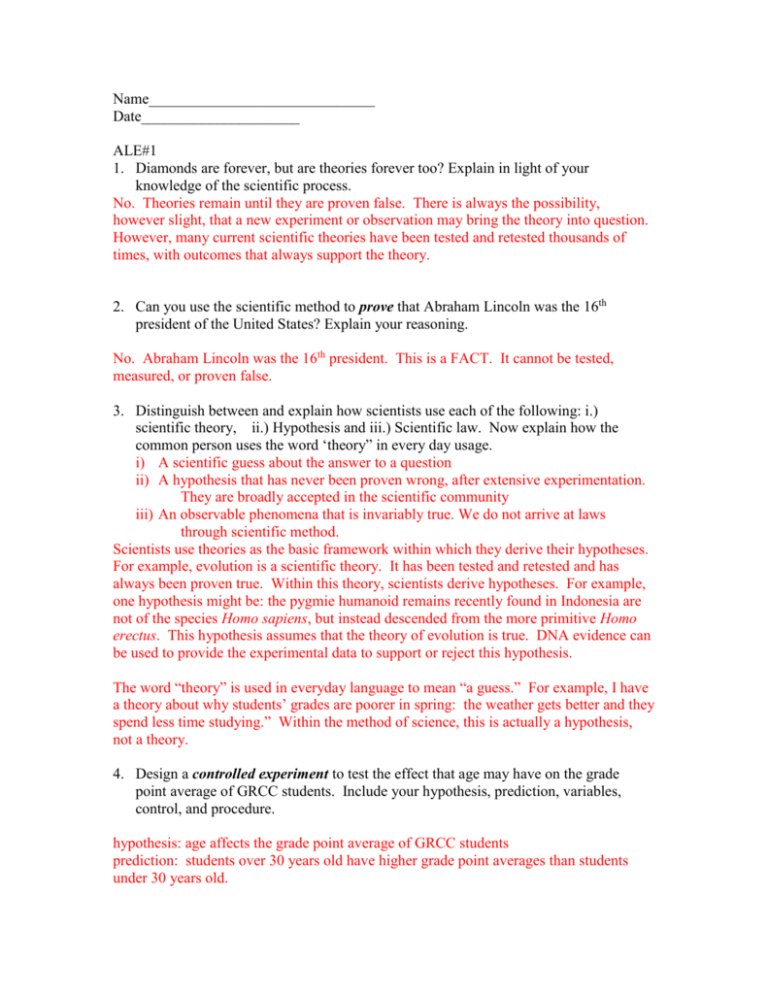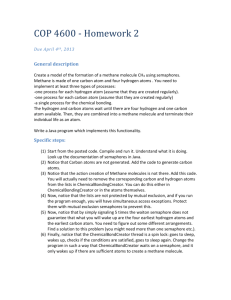1 - Tacoma Community College
advertisement

Name______________________________ Date_____________________ ALE#1 1. Diamonds are forever, but are theories forever too? Explain in light of your knowledge of the scientific process. No. Theories remain until they are proven false. There is always the possibility, however slight, that a new experiment or observation may bring the theory into question. However, many current scientific theories have been tested and retested thousands of times, with outcomes that always support the theory. 2. Can you use the scientific method to prove that Abraham Lincoln was the 16th president of the United States? Explain your reasoning. No. Abraham Lincoln was the 16th president. This is a FACT. It cannot be tested, measured, or proven false. 3. Distinguish between and explain how scientists use each of the following: i.) scientific theory, ii.) Hypothesis and iii.) Scientific law. Now explain how the common person uses the word ‘theory” in every day usage. i) A scientific guess about the answer to a question ii) A hypothesis that has never been proven wrong, after extensive experimentation. They are broadly accepted in the scientific community iii) An observable phenomena that is invariably true. We do not arrive at laws through scientific method. Scientists use theories as the basic framework within which they derive their hypotheses. For example, evolution is a scientific theory. It has been tested and retested and has always been proven true. Within this theory, scientists derive hypotheses. For example, one hypothesis might be: the pygmie humanoid remains recently found in Indonesia are not of the species Homo sapiens, but instead descended from the more primitive Homo erectus. This hypothesis assumes that the theory of evolution is true. DNA evidence can be used to provide the experimental data to support or reject this hypothesis. The word “theory” is used in everyday language to mean “a guess.” For example, I have a theory about why students’ grades are poorer in spring: the weather gets better and they spend less time studying.” Within the method of science, this is actually a hypothesis, not a theory. 4. Design a controlled experiment to test the effect that age may have on the grade point average of GRCC students. Include your hypothesis, prediction, variables, control, and procedure. hypothesis: age affects the grade point average of GRCC students prediction: students over 30 years old have higher grade point averages than students under 30 years old. independent variable: age dependent variable: grade point experimental group: those over 30 control group: those under 30 controlled variables: all students attend GRCC. procedure: all grade point averages for students over 30 years old will be averaged at the end of the quarter. all grade point averages for students under 30 years old will be averaged at the end of the quarter. 5. Darwin’s theory of natural selection is occasionally criticized by the layperson as being “only a theory.” Comment on the validity of this statement in light of what you know about the scientific method and how a hypothesis becomes a scientific theory. Hint: Think about how our society uses the term theory, versus the scientific meaning of a theory. The layperson may say that natural selection is “only a theory”. What they mean is that natural selection is just a guess. Those of us whom have studied science know that natural selection is a scientific theory. This means that natural selection has been tested and retested many times, in many different settings and places and times. There are currently no other scientific theories to explain the divergence of species. 6. Often if a person can visualize a concept they will understand and remember the concept. Here are some terms that are used regularly in chemistry and are important to understand clearly. Create a diagram (or diagrams) that would help someone understand what is meant by the following terms: matter, atoms, elements, chemical bonds, molecules, and compounds. answers will vary 7. Atoms consist primarily of three kinds of subatomic particles. Identify and describe particles by completing the chart below. Name of subatomic particle electron proton neutron Electric charge negative positive neutral/none 8. Atoms are always electrically neutral, that is they are not positively or negatively charged. From this fact, how do the number of protons compare to the number of electrons in an atom? They are equal in number 9. A lump of the element gold has different properties than a lump of the element carbon. An atom of gold has different properties than an atom of carbon. How can atoms of gold and carbon have different properties if all atoms consist of the same subatomic particles? What determines the identity of an atom? The number of protons determines the property of the atom or element. The number of electrons can change (the atoms becomes an ion), and the number of neutrons can change (the atom becomes an isotope), but the atom is still the same element. The # of protons cannot change. You cannot change one element into another. 10. What is an ion? Provide several examples of some ions using chemical formulae and written names. An ion is an atom that has gained or lost an electron, resulting in a net positive or negative charge. An example is the chloride ion: Cl- that becomes part of table salt: NaCl by creating an ionic bond with a sodium ion: Na+. 11. Water consists of tiny particles called molecules. Each water molecule contains ___2__ atoms of hydrogen __________covalently_________ bonded to ____one____ atom of oxygen. In the space below draw one water molecule and label the bonds. Your drawing should have an oxygen atom attached to two hydrogen atoms. The bonds should be labeled as covalent bonds. Use figure 2.9 in your text as a guide. 12. Distinguish between the following kinds of chemical bonds: covalent bond, hydrogen bonds, and ionic bonds, giving an example of each. An ionic bond forms when a positive ion is attracted to a negative ion. Example: Na+ plus Cl- makes NaCl. A covalent bond forms when two atoms share electrons in their outermost shell in order to fill that shell. Example: hydrogen gas, H2. Each H atom has one electron in its outermost shell, which can hold a total of 2 electrons. By sharing their atoms, both atoms can complete their shell. Hydrogen bonds are electrical attractions between the slightly negative end of a molecule with a hydrogen ion (H+), as in water. The oxygen end of a water molecule is slightly negative and is attracted to the slightly positive hydrogen end of another water molecule. 13. Whirligig beetles are small insects that run around on water as if it were a hard surface, and they stay completely dry. How are they able to do this? Hydrogen bonding creates surface tension in water. The whirligig beetle is not massive enough to break the force of this surface tension. 14. List the four life-supporting properties of water that result from the tendency of water molecules to form hydrogen bonds. Discuss how each of these properties is important to life. Versatility of water as a solvent – it can dissolve many substances, such as salt. This is important in the osmoregulation of our internal body fluids/organs. Water’s cohesive nature. This is especially important in the movement of water withing plants and trees. Water’s ability to moderate temperature. Since most of our planet is covered in water, the planet’s temperate remains in the moderate range, that is most favorable to life. Ice floats – the density of ice is less than water, which means it will float on top of liquid water. This insulates the water beneath, preventing it and all the organisms within it from freezing.








